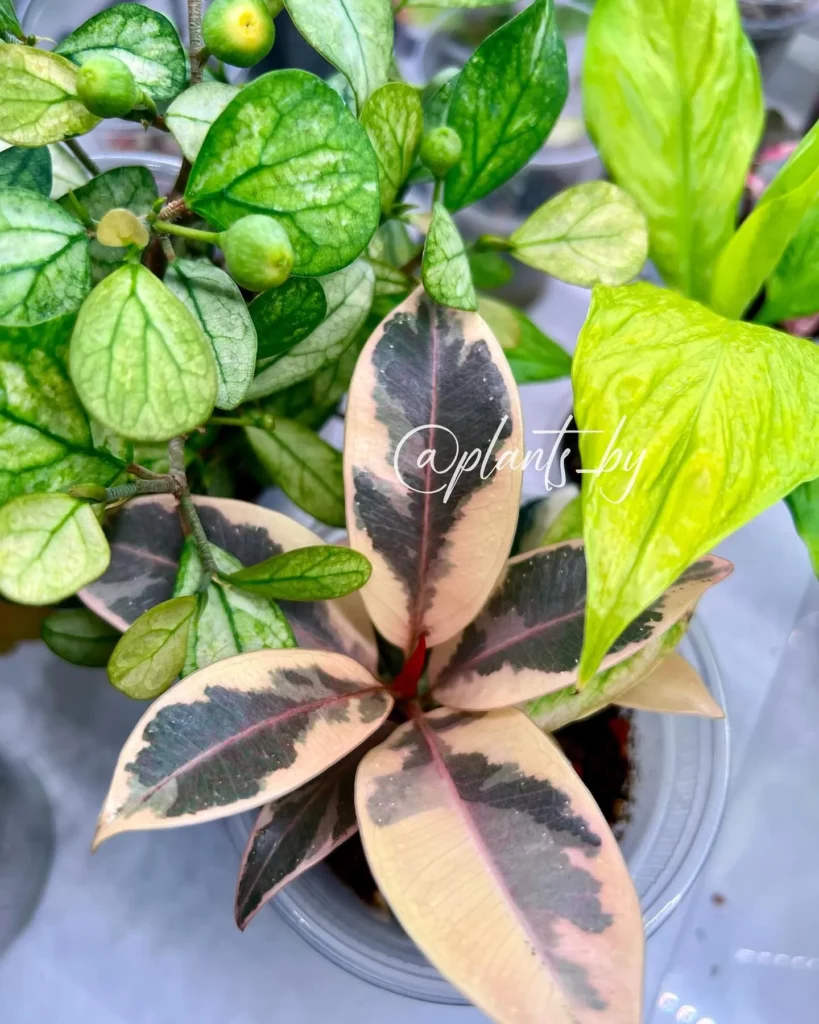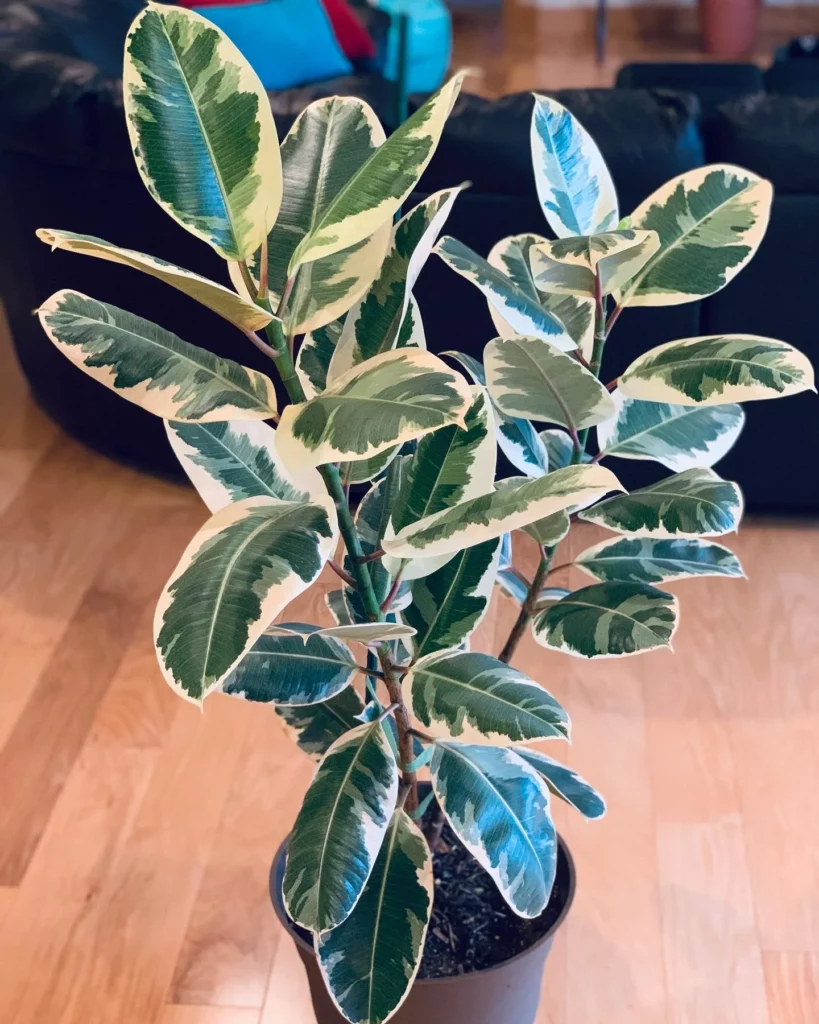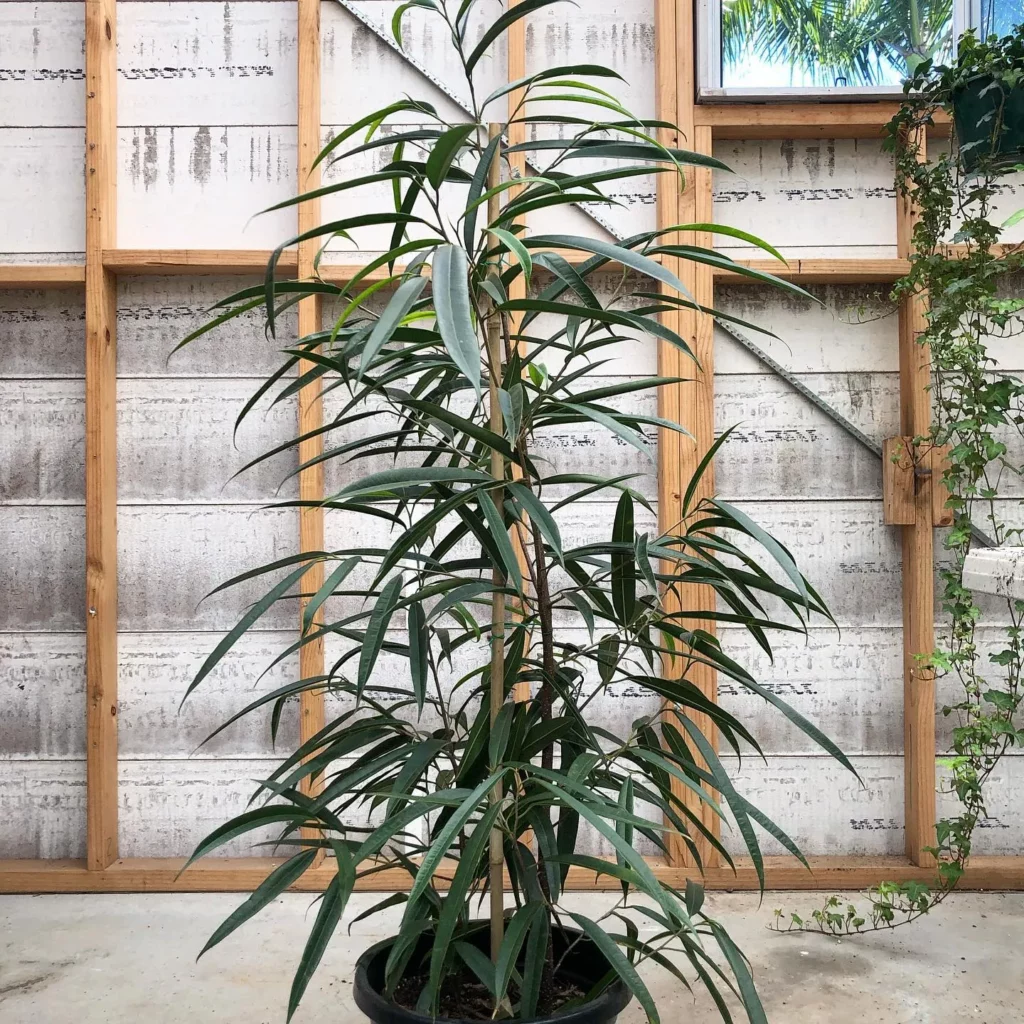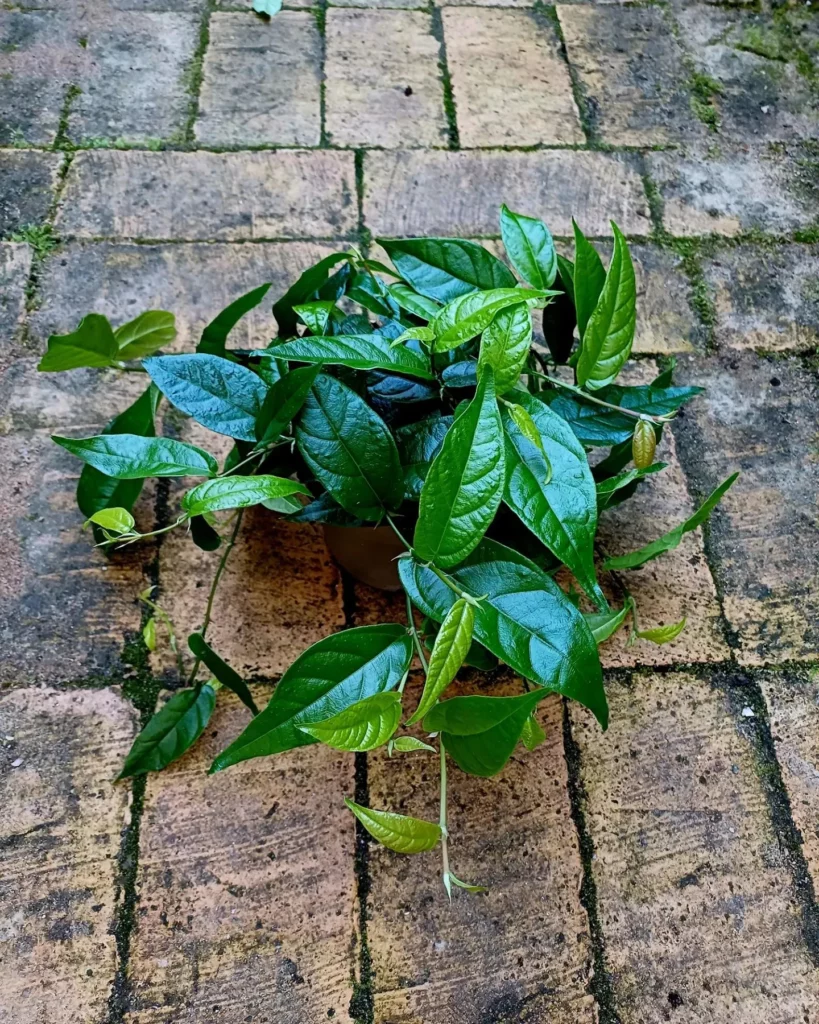The Ficus elastica ‘Variegata’ is a visually striking houseplant with its large, glossy leaves that display variegation patterns of creamy white or yellowish-green, beautifully contrasting against the deep green background.
This variegated rubber plant is known for its eye-catching foliage, adding a touch of elegance and vibrancy to any indoor space. The leaves are typically broad, oval-shaped, and have a smooth texture, making them stand out even more.
Key Takeaways:
- Ficus elastica ‘Variegata’ is a hardy houseplant that requires minimal care.
- The plant thrives in bright indirect light but can tolerate lower light conditions.
- Watering needs to be done when the top inch of soil becomes dry, and the plant prefers well-draining soil to avoid root rot.
- The plant requires temperatures between 60°F to 80°F and can be sensitive to sudden weather changes.
- Ficus elastica ‘Variegata’ does not require high humidity and can do well in average household humidity levels.
Appearance of Ficus elastica Variegata



The variegation patterns on the leaves of Ficus elastica ‘Variegata’ are random and can vary greatly from one leaf to another. Some leaves may have more white or yellowish-green coloration, while others may be predominantly deep green with minimal variegation. This natural variation adds to the plant’s charm and makes each specimen unique.
The Ficus elastica ‘Variegata’ can grow up to a height of 6 to 10 feet, creating an impressive presence in any room. Its lush foliage and distinctive variegation make it a popular choice among plant enthusiasts who appreciate the beauty and aesthetic appeal of plants with variegated leaves.
Whether placed as a focal point or incorporated into a collection of houseplants, the Ficus elastica ‘Variegata’ is sure to captivate attention and enhance the visual appeal of any indoor space.
| Common Name | Scientific Name | Family |
|---|---|---|
| Variegated Rubber Plant | Ficus elastica ‘Variegata’ | Moraceae |
How to Grow Ficus elastica Variegata

Growing Ficus elastica ‘Variegata’ is a rewarding experience, and by following these essential guidelines, you can cultivate a healthy and thriving plant in your indoor space.
1. Light Requirements: Place your Ficus elastica ‘Variegata’ in a well-lit area with bright indirect light. While it can tolerate lower light conditions, it thrives in moderate to bright light. Avoid direct sunlight, as it can scorch the leaves.
2. Soil and Watering: Use well-draining soil to prevent root rot. Water the plant when the top inch of soil becomes dry. Be sure not to overwater, as this can lead to root rot. Allow the excess water to drain out of the pot to avoid sitting water.
3. Temperature and Humidity: Maintain a temperature range between 60°F to 80°F for optimal growth. Avoid exposing the plant to sudden temperature changes. Ficus elastica ‘Variegata’ does well in average household humidity levels and does not require high humidity.
4. Fertilization: Fertilize your Ficus elastica ‘Variegata’ during the spring and summer months using a general houseplant fertilizer. Use half the recommended dosage to prevent over-fertilization. This will provide the necessary nutrients for healthy growth.
5. Propagation and Repotting: Propagate your Ficus elastica ‘Variegata’ through stem cuttings, ensuring each cutting has at least two leaves. Repot the plant every one to two years or when it outgrows its current container. This will provide fresh soil and space for continued growth.
| Key Points | Summary |
|---|---|
| Ficus elastica ‘Variegata’ Care Guide | Proper care guidelines for growing Ficus elastica ‘Variegata’ indoors. |
| Indoor Plant Care | Tips and instructions for maintaining healthy indoor plants. |
| Houseplant Care Tips | Useful tips and advice for caring for various houseplants. |
| Ficus elastica Maintenance | Essential guidelines for maintaining the health and appearance of Ficus elastica plants. |
Propagation Tips for Ficus elastica Variegata



If you wish to expand your collection of Ficus elastica ‘Variegata’ or share this beautiful plant with friends and family, propagation is a fantastic way to do so. This method allows you to create new plants from existing ones, giving you more opportunities to enjoy the variegated beauty of the Rubber Plant.
Here are some essential tips to help you successfully propagate Ficus elastica ‘Variegata’.
Gather the necessary materials
Before you begin the propagation process, make sure you have all the necessary materials. You will need a clean pair of pruning shears or scissors, a clean container or pot with well-draining soil, and a rooting hormone (optional but can increase success rates). It’s essential to use sterile tools and containers to prevent the spread of diseases or pests.
Select the right stem cuttings
When selecting stem cuttings for propagation, look for healthy stems that are at least 6 inches long and have at least two sets of leaves. Make a clean cut just below a leaf node, as this is where new roots will emerge. Remove any leaves from the lower half of the cutting to minimize moisture loss during the rooting process.
Step-by-step Propagation Process for Ficus elastica ‘Variegata’
| Step | Description |
|---|---|
| 1 | Prepare the rooting container/pot by filling it with well-draining soil. |
| 2 | Take a healthy stem cutting from the parent plant, ensuring it has at least two sets of leaves. |
| 3 | Remove the lower leaves from the cutting, leaving only a few leaves at the top. |
| 4 | Apply rooting hormone to the freshly cut end of the stem (optional). |
| 5 | Insert the cutting into the soil, ensuring the leaf nodes are covered. |
| 6 | Water the cutting thoroughly and place it in a warm, bright location with indirect sunlight. |
| 7 | Keep the soil consistently moist, but not overly wet, to promote root development. |
| 8 | Monitor the cutting for signs of new growth and root development. |
| 9 | Once the cutting has established roots, you can transplant it into a larger container or pot. |
Light Requirements for Ficus elastica Variegata

Providing the right amount of light is crucial for the health and growth of your Ficus elastica ‘Variegata,’ so let’s dive into its light requirements and how to ensure optimal conditions.
Ficus elastica ‘Variegata’ thrives in bright indirect light, making it an ideal plant for well-lit rooms with windows that receive filtered sunlight. Placing it near a north or east-facing window is usually the best option. However, it can also tolerate lower light conditions, making it adaptable to various indoor environments.
When exposing your Ficus elastica ‘Variegata’ to direct sunlight, be cautious of intense afternoon sun rays, especially during the hotter months. Direct sunlight can scorch the leaves, causing damage.
If your plant is receiving too much light, you may notice pale or yellowing leaves. On the other hand, insufficient light can result in stretched, leggy growth and smaller leaves.
It’s essential to observe your plant’s response to the available light and make necessary adjustments. If your Ficus elastica ‘Variegata’ is not receiving enough light, you can supplement its requirements by using artificial grow lights.
These lights should be placed a few feet above the plant and positioned to distribute light evenly.
| Light Requirement | Preferred Light Conditions |
|---|---|
| Bright Indirect Light | Well-lit rooms with filtered sunlight |
| Tolerates Lower Light | Adaptable to various indoor environments |
| Direct Sunlight | Be cautious of intense afternoon sun rays to avoid leaf damage |
| Insufficient Light | Supplement with artificial grow lights to avoid leggy growth |
Soil Requirements for Ficus elastica Variegata



Choosing the right soil type and providing proper drainage are vital factors in maintaining the health and vigor of your Ficus elastica ‘Variegata.’ This popular houseplant prefers a well-draining soil mix that allows excess water to flow through easily, preventing the risk of root rot.
A recommended soil mixture consists of equal parts peat moss, perlite, and potting soil. This combination promotes good drainage while retaining enough moisture for the plant’s roots.
It is important to note that Ficus elastica ‘Variegata’ is intolerant of overly moist conditions and can suffer from root rot if left in soggy soil. To ensure optimal drainage, consider adding a layer of small pebbles or stones at the bottom of the pot before adding the soil mixture. This will create space for excess water to collect and prevent it from saturating the roots.
A well-draining soil mix also helps prevent salt build-up, which can accumulate over time from minerals found in tap water or fertilizers. Salt build-up can lead to leaf discoloration and hinder the plant’s overall health.
To prevent this, it’s advisable to flush the soil occasionally by thoroughly watering the plant until water drains out of the bottom of the pot, effectively flushing out any salt deposits.
| Soil Type | Description |
|---|---|
| Peat Moss | Retains moisture and improves the soil’s water-holding capacity. |
| Perlite | A lightweight volcanic glass that enhances soil aeration and drainage. |
| Potting Soil | A mix of organic materials that provides nutrients and structure to the soil. |
In addition to choosing the right soil type, it’s essential to repot your Ficus elastica ‘Variegata’ every one to two years. As the plant grows and matures, it will require fresh soil and a larger pot to accommodate its expanding root system. Repotting not only ensures adequate space for root growth but also provides an opportunity to refresh the soil and remove any accumulated salts or toxins.
Common Issues and Troubleshooting:
- Yellowing or dropping leaves: This can be a sign of overwatering or poor drainage. Check the moisture levels in the soil and adjust your watering routine if needed.
- Stunted growth: Insufficient nutrients in the soil can lead to slow growth. Fertilize your Ficus elastica ‘Variegata’ during the growing season with a balanced houseplant fertilizer to provide the necessary nutrients for healthy development.
- Soil compaction: Over time, the soil can become compacted, limiting root growth and restricting the intake of nutrients and water. Gently loosen the soil around the plant’s roots during repotting to improve aeration and promote healthy growth.
Potting and Repotting Ficus elastica Variegata

As your Ficus elastica ‘Variegata’ grows, it will eventually require repotting to provide ample space for root development and support continued healthy growth. The frequency of repotting will depend on the plant’s growth rate, but generally, it is recommended to repot every one to two years.
When repotting, select a pot that is one size larger than the current pot to allow for root expansion. Ensure the new pot has drainage holes to prevent waterlogging, which can lead to root rot. Use a high-quality, well-draining potting mix specifically formulated for indoor plants.
Here is a step-by-step guide to repotting your Ficus elastica ‘Variegata’:
- Carefully remove the plant from its current pot, gently teasing out the roots if they appear root-bound.
- Inspect the roots for any signs of damage or disease and trim away any unhealthy or rotting roots.
- Place a layer of fresh potting mix in the bottom of the new pot.
- Position the plant in the center of the pot and fill in the remaining space with potting mix, ensuring the roots are covered and the plant is stable.
- Water the newly repotted plant thoroughly to help settle the soil and eliminate air pockets.
After repotting, provide your Ficus elastica ‘Variegata’ with appropriate care, including consistent watering, adequate light, and regular fertilization. Keep an eye out for any signs of stress or adjustment, such as drooping leaves, and adjust your care routine accordingly.
| Key Considerations for Potting and Repotting Ficus elastica Variegata |
|---|
| Choose a pot one size larger than the current pot |
| Ensure the new pot has drainage holes |
| Use a well-draining potting mix |
| Inspect roots for damage or disease |
| Trim unhealthy or rotting roots |
| Water thoroughly after repotting |
Pruning and Shaping Ficus elastica Variegata



Regular pruning and shaping are essential for keeping your Ficus elastica ‘Variegata’ looking neat, maintaining its desired size, and promoting overall plant health.
Pruning helps remove dead or damaged foliage, encourages new growth, and improves the plant’s aesthetic appeal. Additionally, shaping allows you to control the plant’s growth pattern and prevent it from becoming unruly or overcrowded.
When pruning your Ficus elastica ‘Variegata,’ start by assessing the plant’s overall shape and size. Identify any branches or stems that appear leggy, weak, or out of proportion with the rest of the plant. Use clean, sharp pruning shears to make clean cuts just above a leaf node or bud. This will encourage new growth from the trimmed area and help maintain the plant’s desired shape.
During the pruning process, it’s important to remove any yellowing or browning leaves, as these can indicate nutrient deficiencies or water-related issues. Regularly inspect the underside of leaves for any signs of pests, such as mealybugs or spider mites. If you spot any pests, gently wipe the affected areas with a damp cloth or use an organic insecticidal soap to control the infestation.
To achieve a balanced and symmetrical appearance, rotate your Ficus elastica ‘Variegata’ every few weeks to ensure that all sides receive adequate light. This will prevent the plant from leaning towards a light source and encourage even growth throughout. Remember to remove any dead or fallen leaves from the plant’s base to maintain a clean and tidy appearance.
| Pruning and Shaping Tips for Ficus elastica Variegata |
|---|
| Regularly prune your Ficus elastica ‘Variegata’ to remove dead or damaged foliage. |
| Use clean, sharp pruning shears to make precise cuts just above leaf nodes or buds. |
| Remove yellowing or browning leaves to maintain the plant’s health and appearance. |
| Inspect the underside of leaves for pests and take appropriate measures if an infestation is detected. |
| Rotate the plant every few weeks to ensure even growth from all sides. |
| Keep the plant’s base clean by removing any dead or fallen leaves. |
Temperature Requirements for Ficus elastica Variegata
Providing the right temperature conditions is crucial for the growth and happiness of your Ficus elastica ‘Variegata,’ so let’s explore its temperature requirements in detail. This popular houseplant thrives in temperatures between 60°F to 80°F (15°C to 27°C), making it well-suited for average indoor environments.
Extreme temperature fluctuations should be avoided, as they can stress the plant and hinder its growth. Keep your Ficus elastica ‘Variegata’ away from drafts, such as doorways or windows with significant temperature variations.
If you live in a particularly cold climate or during the winter months, it’s important to protect your plant from cold drafts and ensure it’s placed in a warm spot in your home. Similarly, avoid exposing your plant to direct sunlight or excessively high temperatures, as this can lead to leaf burn and damage.
| Temperature Range | Plant Response |
|---|---|
| 60°F to 80°F (15°C to 27°C) | Optimal growth and health |
| Below 50°F (10°C) | Growth slows down, leaves may drop |
| Above 90°F (32°C) | Leaf curling, discoloration, and heat stress |
Humidity Requirements for Ficus elastica Variegata
While Ficus elastica ‘Variegata’ does not demand high humidity levels, it still benefits from a moderate level of moisture in the air, and I will guide you on how to achieve that. Maintaining adequate humidity can help prevent issues such as leaf browning and promote healthy foliage growth. Here are some tips to ensure the optimal humidity for your Ficus elastica ‘Variegata’.
One simple way to increase humidity is to group your plants together. When plants are placed in close proximity, they create a microclimate that helps to retain moisture in the air. grouping your Ficus elastica ‘Variegata’ with other houseplants can create a more humid environment for your plant to thrive.
Another effective method to increase humidity is to use a humidifier. Placing a small humidifier near your Ficus elastica ‘Variegata’ can help maintain a consistent level of humidity in the air. This is especially beneficial during the drier winter months when indoor humidity levels tend to drop.
If you don’t have a humidifier, you can also create a DIY humidity tray. Simply place a shallow tray filled with water near your plant. As the water evaporates, it will increase the humidity in the surrounding area. Just be sure to keep the water level below the bottom of the pot to prevent overwatering.
| Humidity Levels | Recommended Actions |
|---|---|
| Low humidity (below 30%) | Mist the leaves of your Ficus elastica ‘Variegata’ with water using a spray bottle once or twice a week to provide a temporary boost in humidity. |
| Medium humidity (30-60%) | Regularly monitor the moisture level around your plant. If the air feels dry, consider using a humidifier or humidity tray to maintain optimal humidity. |
| High humidity (above 60%) | Ensure proper air circulation around your Ficus elastica ‘Variegata’ to prevent excessive humidity, which can lead to fungal diseases. Avoid overwatering and make sure the soil is well-draining. |
Watering Ficus elastica Variegata
Watering your Ficus elastica ‘Variegata’ correctly is crucial for establishing a healthy root system and avoiding potential issues caused by water-related imbalances. This plant prefers its soil to be kept consistently moist, but not waterlogged. To determine when it’s time to water, check the top inch of the soil—when it feels dry to the touch, it’s time to water again.
When watering, thoroughly saturate the soil until water drains out of the bottom of the pot. Discard any excess water accumulated in the saucer to prevent waterlogging. This prevents the risk of root rot, a common problem for rubber plants. Remember, overwatering is more detrimental than underwatering for Ficus elastica ‘Variegata’.
It’s important to note that the frequency of watering will depend on factors such as the size of the pot, the amount of light exposure, and the ambient temperature. During the summer months when the plant is actively growing, you may need to water more frequently. Conversely, in the winter when growth slows down, you’ll likely need to water less often.
Lastly, be cautious not to let your rubber plant sit in standing water for an extended period, as it can lead to root rot and other diseases. Adjust your watering routine accordingly to maintain a healthy and thriving Ficus elastica ‘Variegata’.
| Watering Tips for Ficus elastica ‘Variegata’ |
|---|
| Do |
| Water when the top inch of soil is dry |
| Thoroughly saturate the soil and allow excess water to drain |
| Monitor the plant’s water needs based on environmental factors |
| Don’t |
| Overwater the plant, leading to root rot |
| Let the plant sit in standing water for prolonged periods |
Fertilizing Ficus elastica Variegata
Supplying your Ficus elastica ‘Variegata’ with the right nutrients through proper fertilization is vital for maintaining its vibrant foliage and promoting robust growth. This beautiful variegated rubber plant benefits from regular feeding during the active growing season, typically from spring to summer.
Here’s a guide on how to fertilize your Ficus elastica ‘Variegata’ effectively.
1. Choose the right fertilizer: Use a balanced, water-soluble fertilizer formulated for houseplants. Look for a fertilizer with equal or balanced ratios of nitrogen (N), phosphorus (P), and potassium (K). This will provide your Ficus elastica ‘Variegata’ with a complete set of essential nutrients.
2. Follow the dosage instructions: Dilute the fertilizer according to the instructions on the package, typically using half the recommended dosage. Overfertilizing can lead to fertilizer burn and damage the plant’s roots, so it’s essential to apply the correct amount.
3. Apply during the growing season: Fertilize your Ficus elastica ‘Variegata’ every two to four weeks during the active growth period. This will provide a steady supply of nutrients to support healthy foliage development and encourage robust growth.
4. Water after fertilizing: After applying the fertilizer, water the plant thoroughly to ensure the nutrients are distributed evenly and reach the plant’s root zone. This will help prevent fertilizer buildup and potential salt accumulation in the soil.
| Fertilizer Type | Nutrient Ratio | Application Frequency |
|---|---|---|
| Water-soluble houseplant fertilizer | Equal or balanced NPK ratio | Every 2-4 weeks during the growing season |
Pest Control for Ficus elastica Variegata
Protecting your Ficus elastica ‘Variegata’ from potential pests is an important aspect of caring for this plant, and I will guide you through the necessary steps. Even though this plant is generally resistant to pests, it can occasionally be susceptible to certain insects. By following these pest control measures, you can ensure the health and vitality of your Ficus elastica ‘Variegata’.
Identifying Common Pests
Before implementing any pest control methods, it is crucial to identify the specific pests affecting your Ficus elastica ‘Variegata.’ The most common pests to watch out for include:
- Spider mites: These tiny pests can be identified by the fine webbing they create on the leaves. They can cause discoloration and damage to the foliage.
- Mealybugs: Mealybugs are small, white, cottony insects that feed on the plant’s sap. They can cause stunted growth and yellowing of leaves.
- Aphids: Aphids are small, soft-bodied insects that can appear in various colors. They feed on the plant’s sap and can cause distortion and curling of leaves.
Natural Pest Control Methods
When it comes to controlling pests on your Ficus elastica ‘Variegata,’ it is best to start with natural and non-toxic methods before resorting to chemical treatments. Here are some effective natural pest control methods:
- Manual removal: If you spot any visible pests on your plant, you can gently remove them using a cotton swab dipped in rubbing alcohol or soapy water. This helps to eliminate the immediate problem.
- Neem oil spray: Neem oil is a natural insecticide that can be mixed with water and sprayed onto your plant. It works by suffocating and deterring pests. Ensure thorough coverage of all plant surfaces.
- Introduce beneficial insects: Ladybugs and lacewings are natural predators of many common pests. You can attract these beneficial insects to your garden or indoor space by planting flowers they are attracted to, such as marigolds or daisies.
Chemical Treatments
If natural pest control methods do not effectively manage the infestation, you may need to consider chemical treatments as a last resort. Always carefully follow the instructions and precautions provided with any chemical product and consider using organic options whenever possible.
| Chemical | Targeted Pest | Application Method |
|---|---|---|
| Insecticidal soap | Aphids, mealybugs | Dilute as per instructions and apply directly to affected areas. |
| Systemic insecticide | Spider mites, persistent aphid infestations | Dilute and apply to the soil according to package instructions. The plant absorbs the insecticide, which then affects the pests. |
Common Problems with Ficus elastica Variegata
Despite being a hardy plant, Ficus elastica ‘Variegata’ can occasionally face certain issues, but with proper care and attention, you can overcome these challenges successfully. Here are some common problems you may encounter when caring for this beautiful variegated rubber plant:
- Small Leaves or Lack of Growth: If your Ficus elastica ‘Variegata’ is not producing new leaves or the leaves are smaller than usual, it may be due to inadequate light. This plant thrives in bright indirect light, so try moving it to a brighter location. You can also consider supplementing with artificial grow lights to enhance its growth.
- Root Rot: Overwatering can lead to root rot, a common issue in rubber plants. To prevent this, ensure that the top inch of soil is dry before watering again, and always use well-draining soil. If you suspect root rot, gently remove the plant from its pot, trim away any affected roots, and repot it in fresh soil.
- Browning Leaves: Low humidity levels can cause the leaves of Ficus elastica ‘Variegata’ to turn brown or crisp. Increase humidity around the plant by misting it regularly or placing a tray of water nearby. You can also consider using a humidifier to maintain suitable humidity levels.
- Insect Infestation: Common pests that may attack your variegated rubber plant include mealybugs and spider mites. To control these pests, regularly inspect your plant for signs of infestation, such as webbing or sticky residue. If you spot any pests, wipe them off with a damp cloth and consider using organic insecticides if necessary.
Troubleshooting Guide: Common Problems and Solutions
| Problem | Solution |
|---|---|
| Small Leaves or Lack of Growth | Move the plant to a brighter location or provide artificial grow lights for supplemental lighting. |
| Root Rot | Water the plant only when the top inch of soil is dry, use well-draining soil, and repot if root rot is present. |
| Browning Leaves | Increase humidity levels by misting the plant, placing a tray of water nearby, or using a humidifier. |
| Insect Infestation | Regularly inspect the plant for signs of pests, wipe them off with a damp cloth, and consider using organic insecticides if needed. |
Conclusion
Congratulations! You have now reached the end of this comprehensive Ficus elastica Variegata Care Guide, equipping you with the knowledge and insights needed to cultivate and maintain a healthy and visually stunning rubber plant in your American home.
Ficus elastica ‘Variegata,’ also known as the Rubber Plant, is a hardy houseplant that requires minimal care. With its distinctive variegated leaves, it adds a touch of elegance to any indoor space. To ensure optimal growth and longevity, it’s important to provide the right conditions and follow proper care techniques.
First and foremost, Ficus elastica ‘Variegata’ thrives in bright indirect light. While it can tolerate lower light conditions, placing it in a well-lit spot will promote vibrant leaf colors and robust growth. When it comes to watering, allow the top inch of soil to dry out before watering again to avoid overwatering. Well-draining soil is crucial to prevent root rot, so make sure to choose a potting mix that provides good drainage.
Maintaining suitable temperatures between 60°F to 80°F is essential for the plant’s well-being. Sudden weather changes can be detrimental, so try to keep it away from drafts or cold drafts. Thankfully, Ficus elastica ‘Variegata’ does not require high humidity and can thrive in average household humidity levels. It’s important to note, however, that the plant is toxic to pets, so keep it out of their reach.
Regular fertilization during the spring and summer months with a general houseplant fertilizer, using half the recommended dosage, will help promote healthy growth. As Ficus elastica ‘Variegata’ has a fast growth rate, regular pruning and trimming will be necessary to maintain its height and shape indoors. Additionally, keep an eye out for common pests and diseases, and take appropriate measures to protect your plant.
By following the guidelines provided in this care guide, you can enjoy the beauty of Ficus elastica ‘Variegata’ and create a lush indoor environment that is both visually appealing and beneficial for your overall well-being. Happy gardening!
Make sure to check out our article on Ficus elastica Burgundy Care Guide. And after reading that Ficus article, check out our article on Ficus benjamina Weeping Fig Care Guide.
FAQ
Q: What is the best light condition for Ficus elastica ‘Variegata’?
A: Ficus elastica ‘Variegata’ thrives in bright indirect light but can tolerate lower light conditions.
Q: How often should I water my Ficus elastica ‘Variegata’?
A: Watering should be done when the top inch of soil becomes dry, and the plant prefers well-draining soil to avoid root rot.
Q: What temperature range does Ficus elastica ‘Variegata’ prefer?
A: Ficus elastica ‘Variegata’ requires temperatures between 60°F to 80°F and can be sensitive to sudden weather changes.
Q: Do I need to provide high humidity for Ficus elastica ‘Variegata’?
A: Ficus elastica ‘Variegata’ does not require high humidity and can do well in average household humidity levels.
Q: When and how should I fertilize my Ficus elastica ‘Variegata’?
A: Fertilization can be done with a general houseplant fertilizer during the spring and summer months, using half the recommended dosage.
Q: How fast does Ficus elastica ‘Variegata’ grow?
A: Ficus elastica ‘Variegata’ has a fast growth rate and can grow up to 24 inches per year.
Q: Is Ficus elastica ‘Variegata’ toxic to pets?
A: Yes, Ficus elastica ‘Variegata’ is toxic to pets and should be kept out of their reach.
Q: How should I care for Ficus elastica ‘Variegata’?
A: Proper care includes placing the plant in a pot with moist well-draining soil, trimming it to maintain height indoors, and protecting it from insects and diseases.
Q: How can I propagate Ficus elastica ‘Variegata’?
A: Ficus elastica ‘Variegata’ can be propagated through stem cuttings and should be repotted every one to two years.
Q: What are common issues with Ficus elastica ‘Variegata’?
A: Common issues include small leaves or lack of growth due to inadequate light, root rot from overwatering, and browning leaves from low humidity.




